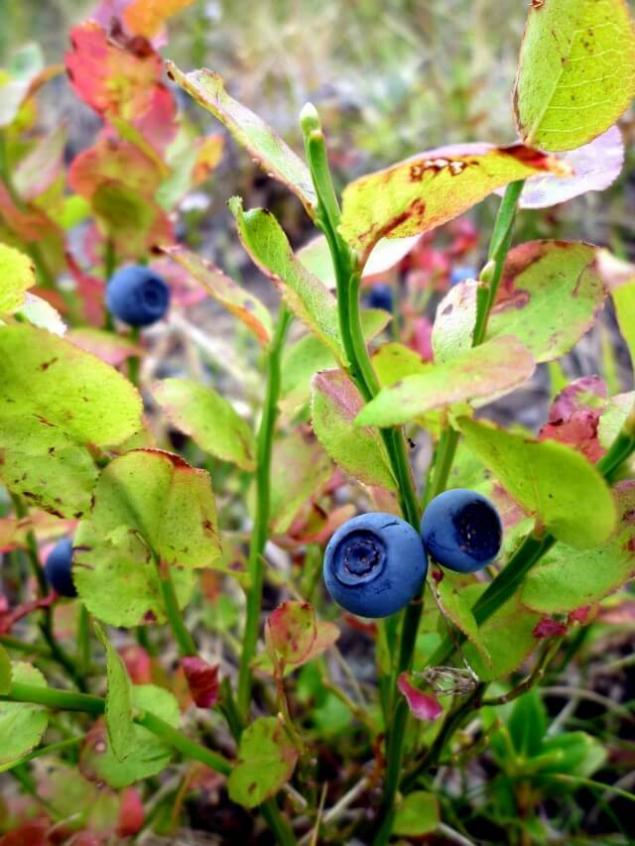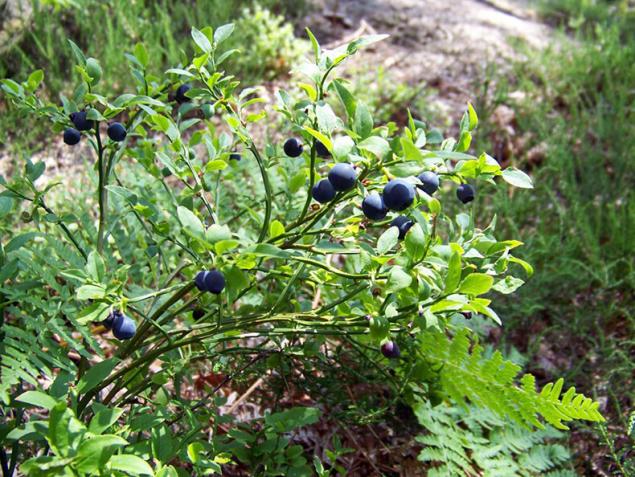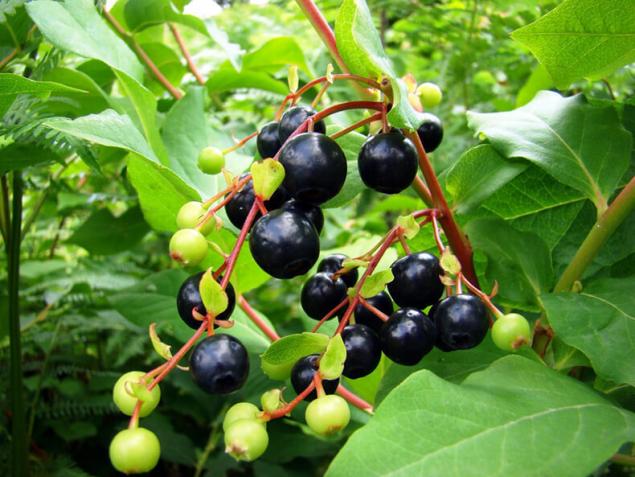841
How to grow blueberries in the country
There is a legend about blueberries. "Long ago it was. In the dense, impenetrable forests, in the neighbourhood people lived dwarves. Found out about them untold riches, the people began everywhere to dig, dig, searching for treasures. Left gnomes out of their homes. Poor folk day and night wandering through the dark, inhospitable forest in the hope of some protection. No one came to their aid. And only blueberry Bush that sheltered them, hid under its branches. In gratitude, the dwarves settled the blueberries around the world".
Our ancestors used the stems and leaves of bilberry in various spheres of life, in the handicraft tanning industry by leather painted in brown and yellow. From these berries the artists produced purple and violet colours (in the first case, took upland blueberry, the second – ramanou ( ramen – fir forest), and when mixing fruit juice with other components of the received dye for wool and fabric.
Even in the Caucasus, grows blueberries, although different from our Northern. There is a tree up to 3 metres, leaves are much larger, and the fruits are black in color, pleasant to the taste, though without the coloring of the juice.

Blueberry, or Bilberry, or Blueberry mortality (Vaccinium myrtillus).
July 22, according to folk calendar day pancratius and Cyril. The beginning of the collection of blueberries, the blueberry day. "Blueberry would be taken from the belly of disaster." In the old days said: blueberries restores health and increases the perception of the world. Original name of teramedica. Was known as this berry is wonderful. She had the assist in the harvest and hay time time. Plenty relied every day blueberries are old and small (especially in summer). Them from all diseases was protected by this berry, healed ulcers of the stomach, the blood was cleaned, the liver healed.
In forest edges, collecting blueberries included in the mandatory annual ritual of berry pieces. Some for speed of data collection adapted to comb the blueberry bushes special crests. Of course, it's faster, but Sora much.

Collecting blueberries.
Description of blueberry
Blueberry, or Bilberry, or Blueberry mortality (Vaccínium myrtíllus) is a species of perennial low-growing shrubs of the genus Vaccinium of the family Ericaceae.
Blueberries — shrub 15-30 cm Branches branch off from the main trunks at acute angles. The leaves are alternate, finely crenate-serrate, ovate, coriaceous, deciduous in winter. Rainwater channeled in leaves and petioles is given to branches with deep grooves, which rolls down to the root. The plant has a creeping rhizome that gives a great number of shoots.
Blueberries bloom in may. The flowers are greenish-white, right, sit on one. The Corolla has 5 teeth. Limb of the calyx undivided. Stamens 10. Pistil — one. Ovary inferior. The flower is tilted down, and this protects the pollen from moisture. The main pollinators of the flowers are domesticated bees and bumblebees.
The fruits of the blueberry bluish-black, purple inside, very well allocated for yellowing leaves. The fruits are eaten by forest birds, which do carry their indigestible seeds. The fruits are edible.
Berries and leaves are used for medicinal purposes. Sometimes blueberries are also grown for ornamental purposes in the Alpine coaster.
In the nature of bilberry grows mainly in the Northern areas — in forests, mainly pine and swamps.

Blooming Bush of a bilberry.
Growing blueberries
The choice of location for chernichnie
Temperature requirements of cultivated blueberry is comparable with the requirements of the currant. Low winter temperatures are unlikely to cause her damage. However, if between harvest and the onset of cold weather is less than 40-50 days, early frosts to about -10°C can cause damage to the bushes. But damage from late spring frosts can not be afraid, as the time of flowering of bilberry in the second half of may.
Cultural blueberry is very sensitive to moisture, so you always need to take care of uniform moderate soil moisture. On light soils is very useful close to the groundwater level (30-90 cm), but permanent water stagnation unfavorable for cultivated blueberries. Unlike the forest, the cultural blueberry is better growing in the shade, and gives the greatest yields in Sunny locations.
Requirements of cultivated blueberries to the soil is very specific, because it grows well only on acidic soils. The soil reaction is measured by pH units, should be within a pH of 3.8, and only in exceptional cases it is possible to grow blueberries in soils with higher pH values when the appropriate soil care.
Rich humus soil, including sandy, are best suited for growing of cultivated blueberries, but the bushes before planting, the soil must be properly prepared.
Preparation of soil for planting blueberries
Soil preparation depends on her reaction. On light soils with a pH less than 5.0, it is sufficient to improve the soil to a depth of about 20 cm making a peat crumb, enriched with nutrients; and in planting hole should be additional peat litter mixed with sawdust, shredded bark or rotted oak leaves, the chopped kitchen peelings.
Most garden soils not sufficiently acidic for the growing of cultivated blueberries. Have planted bushes will soon begin to appear yellow leaves, the bushes almost stop growing and eventually die. Successful farming is possible only if adequate preparation of the soil.
This requires each hive to make a pit of size 150 cm x 150 cm and depth of 60 cm or to dig a ditch of the same width and depth. Soil from the pits is mixed in ratio 2:1 with peat, rotted oak leaves, etc., and in heavy soils add river sand
The addition of 1 m3 150-250 g powdered sulfur (sulfur color) further acidify the soil. All these works it is necessary to conduct in a timely manner, so that the soil in the pits has a chance to settle. When planting the bushes in October, all these works must be completed not later than the beginning of September.

Blueberry, or Bilberry, or Blueberry mortality (Vaccinium myrtillus).
Planting blueberries
As a rule, preferable to planting blueberries in October and until the beginning of November, but you can plant shrubs and in the spring from March to April. The best planting material is a two-three year old bushes, but older plants are still taking root and soon begin to bear fruit. Rooting is faster when plants are planted with a lump of earth on the roots, and it is therefore advisable to take the material from the nursery also with a lump or a vessel, if it is grown in it. If the soil is prepared for planting well enough in the landing to acccess recess corresponding to the volume of roots with a lump.
When planting kom loosened around the roots and carefully spread fibrous roots. The soil from the planting hole mixed with peat and river sand, and this mixture is filled to the hole, after which the feet of compacted soil around the bushes and abundantly watered. Very good to mulch the pick-blueberries sawdust, fallen leaves or peat because it helps retain moisture and the fall planting provides protection from frost. Bushes are planted at the same depth at which they grew in the nursery.
If the blueberry bushes cannot be planted immediately after purchase, you must place them in the shade and take care of the moisture. Parched com, or the vessel can easily lead to loss of plants.
Old blueberry bushes can be transplanted, but only with a corresponding lump of earth. After planting, all branches are cut to a height of 10-30 cm
Care of blueberries
Better care of the soil in plantings of cultivated blueberries is applying a layer of sawdust thickness of 10 cm, which is mixed with the top layer of soil and is always maintained in a well hydrated state. Chopped kitchen cleaning is also affected positively. All other types of coating (straw, dead leaves, etc.) have had a less good effect, but they are better than the absence of any coating.
If there is no mulch material, the soil throughout the year is necessary to repeatedly loosen on a very small depth (not more than 3 cm). The closer to the Bush, the more superficial must be loosening, as the roots of blueberry are located also at the surface of the soil.

Blueberry, or Bilberry, or Blueberry mortality (Vaccinium myrtillus).
Fertilizer blueberries
Organic fertilizer, especially on light, sandy soils, and on soils poor in humus, is an important event for increasing yields of cultivated blueberries. Well-rotted manure, rich in nutrients is compost or peat litter, enriched with nutrients, such as birds droppings and mineral fertilizers — all this is suitable to ensure the shrubs with organic fertilizers. Depending on the material and conditions every 2-3 years it is advisable to seal the top layer of soil around the bushes 2-4 kg/m2 of organic fertilizers.
Fertilizers along with providing bushes with nutrients should also help to regulate the soil acidity. On soils with pH from 4.0 to 5.0 should be used only ammonium sulfate, kalimagnesia (sulfate of potassium and magnesium) and superphosphate.
Of complex fertilizers for blueberries fit for only non-chlorine blue paatoksen or "aciplex" — fertilizing salt marsh plants and conifers.
For fertilizing cultivated blueberries can give the following recommendations (g/m2).
Petscan blue (10-6-25)
Young bushes
Fruit bushes
The first dose (March—April)
30
60
The second dose (beginning of June)
20
3
The first fertilization should be preferred "aciplex", and the second — petscan blue. Distribute the fertilizer evenly around the shrubs and very shallow close up hoe in the soil. If you decide to fertilize dissolved salts dissolve only 10-20 g per 10 liters of water, and then the total dose needed to make in several doses at intervals of 10 days. The second dose (in June) for older bushes and for very large yields increase by 10-20 g/m2. Every 2-3 years it is necessary to test the reaction of the soil. At pH values above 5.0 should be given annually to scatter around each Bush 50-60 g of powdered sulfur until the desired pH value. However, in most cases, the use of sawdust for mulching around the bushes will already be enough to regulate the soil acidity.
Principal blueberry
Bilberry — Vaccinium myrtillus.
Bilberry grows in the European part of Russia, Western and Eastern Siberia, the far East, in the Northern part of North America. Grows in deciduous and coniferous forests, tundra, forest-tundra, sphagnum bogs, in the mountains up to 2000 m above sea level. Often dominates the vegetation, forming extensive thickets. Protected in reserves.
Blueberry has a wide ecological amplitude. Humidity low, as occurs on the margins of swamps and wet forests, and dry the bleached areas. Prefers insolated places, but can grow on shaded, however, on very open sites, often fully or partially dies. To temperature fluctuations are more sensitive than cranberries. Prefers a richer soil than cranberries. Grows on the plains and in the mountains rising to the height of 2800 m above sea level. but at the upper forest boundary is usually not fruiting.

Blueberry, or Bilberry, or Blueberry mortality (Vaccinium myrtillus).
Caucasian bilberry — Vaccinium arctostaphylos
Blueberry Caucasian, or Caucasian Cernicky is the Only tertiary relic species growing on the territory of the former Soviet Union, rising in the mountains to the upper forest belt. Distributed in the Caucasus and Northern Asia Minor (as well as in South-Eastern Bulgaria and in Northern Iran. Grows mainly in the mountains at the altitude 1000-2000 m above sea level. the sea, beech and fir - spruce-beech, at least in the chestnut and oak forests. In the zone of subalpine crooked forms thickets. Protected in reserves.
Is a large deciduous shrub or small tree, height up to 2-3 m, with edible fruits, native to Colchis forests and glades. The leaves (6-8 cm long) and fruit larger than those of bilberry. Blossoms in may — July; fruits ripen in July — August. Blueberries are Caucasian used along with berries of a bilberry.

Blueberry Caucasian, or Caucasian Chemicznych (Vaccinium arctostaphylos).
Valnerina blueberry — Vaccinium ovalifolium.
Blueberry valnerina — species of plants from North America Primorye, Sakhalin island, commander Islands, Kuril, the Aleutian, Japan, and North America. Grows in coniferous and mixed forests on mountain slopes and in the swampy lowlands, thickets of cedar often forms large thickets.

Blueberry valenrina, or Chemicznych offlinelist, or Vaccinium ballistic (Vaccinium ovalifolium).
Useful properties of blueberries and methods of use
Long known that blueberries improve eyesight and reduce eye fatigue. It is proved that bilberry accelerates the regeneration of retinal. Blueberries on the menu of astronauts.
Another amazing property of blueberry found the American scientist from Boston George. Joseph, a leading expert on aging, who reported that laboratory tests conducted by them have proved a rich blueberry diet is effective against such symptoms of ageing like loss of memory, muscular force, sight and infringement of coordination of movements.
For therapeutic purposes are the leaves and Mature berries of a bilberry without the peduncle. The berries are prepared broth (50 g of dried berries to 500 ml water) and drink it during the day in chronic diseases of the gastrointestinal tract, diarrhea, mild forms of diabetes, kidney stones, bleeding, anemia, sore throat, inflammation of the bladder and the weakening of its contractile ability, bedwetting, gout, rheumatism, metabolic disorders.
A decoction of the berries is also used for enemas and compresses hemorrhoids, psoriasis, eczema, burns. Decoction or infusion of leaves (1:20) blueberry treat diabetes, inflammation of the gums, throat, kidney and renal pelvis, liver disease and pancreas. Drink 1/2 Cup 3-5 times a day.
Fresh, dried and cooked fruits blueberries (decoction, infusion, juice, and jelly) is used as an antiseptic, astringent, antiseptic, anti-bacterial; diarrhea, acute enterocolitis, hypoacid gastritis, dysentery, heartburn, cystitis, urethritis, rheumatism (as an analgesic). Blueberries mixed with strawberry is widely used in anemia, kidney stones; as antiscorbutic vitamin; when ascites, diabetes; in the form of lotions, ointments, thick broth and extract — eczema, ringworm, burns. Infusion and decoction of the fresh bilberry fruit is used for rinsing with stomatitis, pharyngitis, sore throat. A decoction of bilberry fruit is used in enemas and poultices for hemorrhoids, as drink with enuresis.
Small shrubs for your area
How to make a hammock with your own hands
A decoction of blueberries thick: 100 g of dried raw pour 500 ml of boiling water, boil until the liquid is reduced to 250-300 ml. Applied externally in the form of compresses, changing the bandage after 4-5 hours
Ointment from the fruit of blueberries: fresh or cooked fruit are ground so that they have the consistency of ointment. Applied externally, applying a thick layer on the affected area (eczema, psoriasis, burns, or as a pain reliever in rheumatism, gout, neuritis). Change the gauze dressing is changed daily, the remains are washed clean of serum.published
P. S. And remember, only by changing their consumption — together we change the world! ©
Source: www.botanichka.ru/blog/2010/07/06/bilberry/
Our ancestors used the stems and leaves of bilberry in various spheres of life, in the handicraft tanning industry by leather painted in brown and yellow. From these berries the artists produced purple and violet colours (in the first case, took upland blueberry, the second – ramanou ( ramen – fir forest), and when mixing fruit juice with other components of the received dye for wool and fabric.
Even in the Caucasus, grows blueberries, although different from our Northern. There is a tree up to 3 metres, leaves are much larger, and the fruits are black in color, pleasant to the taste, though without the coloring of the juice.

Blueberry, or Bilberry, or Blueberry mortality (Vaccinium myrtillus).
July 22, according to folk calendar day pancratius and Cyril. The beginning of the collection of blueberries, the blueberry day. "Blueberry would be taken from the belly of disaster." In the old days said: blueberries restores health and increases the perception of the world. Original name of teramedica. Was known as this berry is wonderful. She had the assist in the harvest and hay time time. Plenty relied every day blueberries are old and small (especially in summer). Them from all diseases was protected by this berry, healed ulcers of the stomach, the blood was cleaned, the liver healed.
In forest edges, collecting blueberries included in the mandatory annual ritual of berry pieces. Some for speed of data collection adapted to comb the blueberry bushes special crests. Of course, it's faster, but Sora much.

Collecting blueberries.
Description of blueberry
Blueberry, or Bilberry, or Blueberry mortality (Vaccínium myrtíllus) is a species of perennial low-growing shrubs of the genus Vaccinium of the family Ericaceae.
Blueberries — shrub 15-30 cm Branches branch off from the main trunks at acute angles. The leaves are alternate, finely crenate-serrate, ovate, coriaceous, deciduous in winter. Rainwater channeled in leaves and petioles is given to branches with deep grooves, which rolls down to the root. The plant has a creeping rhizome that gives a great number of shoots.
Blueberries bloom in may. The flowers are greenish-white, right, sit on one. The Corolla has 5 teeth. Limb of the calyx undivided. Stamens 10. Pistil — one. Ovary inferior. The flower is tilted down, and this protects the pollen from moisture. The main pollinators of the flowers are domesticated bees and bumblebees.
The fruits of the blueberry bluish-black, purple inside, very well allocated for yellowing leaves. The fruits are eaten by forest birds, which do carry their indigestible seeds. The fruits are edible.
Berries and leaves are used for medicinal purposes. Sometimes blueberries are also grown for ornamental purposes in the Alpine coaster.
In the nature of bilberry grows mainly in the Northern areas — in forests, mainly pine and swamps.

Blooming Bush of a bilberry.
Growing blueberries
The choice of location for chernichnie
Temperature requirements of cultivated blueberry is comparable with the requirements of the currant. Low winter temperatures are unlikely to cause her damage. However, if between harvest and the onset of cold weather is less than 40-50 days, early frosts to about -10°C can cause damage to the bushes. But damage from late spring frosts can not be afraid, as the time of flowering of bilberry in the second half of may.
Cultural blueberry is very sensitive to moisture, so you always need to take care of uniform moderate soil moisture. On light soils is very useful close to the groundwater level (30-90 cm), but permanent water stagnation unfavorable for cultivated blueberries. Unlike the forest, the cultural blueberry is better growing in the shade, and gives the greatest yields in Sunny locations.
Requirements of cultivated blueberries to the soil is very specific, because it grows well only on acidic soils. The soil reaction is measured by pH units, should be within a pH of 3.8, and only in exceptional cases it is possible to grow blueberries in soils with higher pH values when the appropriate soil care.
Rich humus soil, including sandy, are best suited for growing of cultivated blueberries, but the bushes before planting, the soil must be properly prepared.
Preparation of soil for planting blueberries
Soil preparation depends on her reaction. On light soils with a pH less than 5.0, it is sufficient to improve the soil to a depth of about 20 cm making a peat crumb, enriched with nutrients; and in planting hole should be additional peat litter mixed with sawdust, shredded bark or rotted oak leaves, the chopped kitchen peelings.
Most garden soils not sufficiently acidic for the growing of cultivated blueberries. Have planted bushes will soon begin to appear yellow leaves, the bushes almost stop growing and eventually die. Successful farming is possible only if adequate preparation of the soil.
This requires each hive to make a pit of size 150 cm x 150 cm and depth of 60 cm or to dig a ditch of the same width and depth. Soil from the pits is mixed in ratio 2:1 with peat, rotted oak leaves, etc., and in heavy soils add river sand
The addition of 1 m3 150-250 g powdered sulfur (sulfur color) further acidify the soil. All these works it is necessary to conduct in a timely manner, so that the soil in the pits has a chance to settle. When planting the bushes in October, all these works must be completed not later than the beginning of September.

Blueberry, or Bilberry, or Blueberry mortality (Vaccinium myrtillus).
Planting blueberries
As a rule, preferable to planting blueberries in October and until the beginning of November, but you can plant shrubs and in the spring from March to April. The best planting material is a two-three year old bushes, but older plants are still taking root and soon begin to bear fruit. Rooting is faster when plants are planted with a lump of earth on the roots, and it is therefore advisable to take the material from the nursery also with a lump or a vessel, if it is grown in it. If the soil is prepared for planting well enough in the landing to acccess recess corresponding to the volume of roots with a lump.
When planting kom loosened around the roots and carefully spread fibrous roots. The soil from the planting hole mixed with peat and river sand, and this mixture is filled to the hole, after which the feet of compacted soil around the bushes and abundantly watered. Very good to mulch the pick-blueberries sawdust, fallen leaves or peat because it helps retain moisture and the fall planting provides protection from frost. Bushes are planted at the same depth at which they grew in the nursery.
If the blueberry bushes cannot be planted immediately after purchase, you must place them in the shade and take care of the moisture. Parched com, or the vessel can easily lead to loss of plants.
Old blueberry bushes can be transplanted, but only with a corresponding lump of earth. After planting, all branches are cut to a height of 10-30 cm
Care of blueberries
Better care of the soil in plantings of cultivated blueberries is applying a layer of sawdust thickness of 10 cm, which is mixed with the top layer of soil and is always maintained in a well hydrated state. Chopped kitchen cleaning is also affected positively. All other types of coating (straw, dead leaves, etc.) have had a less good effect, but they are better than the absence of any coating.
If there is no mulch material, the soil throughout the year is necessary to repeatedly loosen on a very small depth (not more than 3 cm). The closer to the Bush, the more superficial must be loosening, as the roots of blueberry are located also at the surface of the soil.

Blueberry, or Bilberry, or Blueberry mortality (Vaccinium myrtillus).
Fertilizer blueberries
Organic fertilizer, especially on light, sandy soils, and on soils poor in humus, is an important event for increasing yields of cultivated blueberries. Well-rotted manure, rich in nutrients is compost or peat litter, enriched with nutrients, such as birds droppings and mineral fertilizers — all this is suitable to ensure the shrubs with organic fertilizers. Depending on the material and conditions every 2-3 years it is advisable to seal the top layer of soil around the bushes 2-4 kg/m2 of organic fertilizers.
Fertilizers along with providing bushes with nutrients should also help to regulate the soil acidity. On soils with pH from 4.0 to 5.0 should be used only ammonium sulfate, kalimagnesia (sulfate of potassium and magnesium) and superphosphate.
Of complex fertilizers for blueberries fit for only non-chlorine blue paatoksen or "aciplex" — fertilizing salt marsh plants and conifers.
For fertilizing cultivated blueberries can give the following recommendations (g/m2).
Petscan blue (10-6-25)
Young bushes
Fruit bushes
The first dose (March—April)
30
60
The second dose (beginning of June)
20
3
The first fertilization should be preferred "aciplex", and the second — petscan blue. Distribute the fertilizer evenly around the shrubs and very shallow close up hoe in the soil. If you decide to fertilize dissolved salts dissolve only 10-20 g per 10 liters of water, and then the total dose needed to make in several doses at intervals of 10 days. The second dose (in June) for older bushes and for very large yields increase by 10-20 g/m2. Every 2-3 years it is necessary to test the reaction of the soil. At pH values above 5.0 should be given annually to scatter around each Bush 50-60 g of powdered sulfur until the desired pH value. However, in most cases, the use of sawdust for mulching around the bushes will already be enough to regulate the soil acidity.
Principal blueberry
Bilberry — Vaccinium myrtillus.
Bilberry grows in the European part of Russia, Western and Eastern Siberia, the far East, in the Northern part of North America. Grows in deciduous and coniferous forests, tundra, forest-tundra, sphagnum bogs, in the mountains up to 2000 m above sea level. Often dominates the vegetation, forming extensive thickets. Protected in reserves.
Blueberry has a wide ecological amplitude. Humidity low, as occurs on the margins of swamps and wet forests, and dry the bleached areas. Prefers insolated places, but can grow on shaded, however, on very open sites, often fully or partially dies. To temperature fluctuations are more sensitive than cranberries. Prefers a richer soil than cranberries. Grows on the plains and in the mountains rising to the height of 2800 m above sea level. but at the upper forest boundary is usually not fruiting.

Blueberry, or Bilberry, or Blueberry mortality (Vaccinium myrtillus).
Caucasian bilberry — Vaccinium arctostaphylos
Blueberry Caucasian, or Caucasian Cernicky is the Only tertiary relic species growing on the territory of the former Soviet Union, rising in the mountains to the upper forest belt. Distributed in the Caucasus and Northern Asia Minor (as well as in South-Eastern Bulgaria and in Northern Iran. Grows mainly in the mountains at the altitude 1000-2000 m above sea level. the sea, beech and fir - spruce-beech, at least in the chestnut and oak forests. In the zone of subalpine crooked forms thickets. Protected in reserves.
Is a large deciduous shrub or small tree, height up to 2-3 m, with edible fruits, native to Colchis forests and glades. The leaves (6-8 cm long) and fruit larger than those of bilberry. Blossoms in may — July; fruits ripen in July — August. Blueberries are Caucasian used along with berries of a bilberry.

Blueberry Caucasian, or Caucasian Chemicznych (Vaccinium arctostaphylos).
Valnerina blueberry — Vaccinium ovalifolium.
Blueberry valnerina — species of plants from North America Primorye, Sakhalin island, commander Islands, Kuril, the Aleutian, Japan, and North America. Grows in coniferous and mixed forests on mountain slopes and in the swampy lowlands, thickets of cedar often forms large thickets.

Blueberry valenrina, or Chemicznych offlinelist, or Vaccinium ballistic (Vaccinium ovalifolium).
Useful properties of blueberries and methods of use
Long known that blueberries improve eyesight and reduce eye fatigue. It is proved that bilberry accelerates the regeneration of retinal. Blueberries on the menu of astronauts.
Another amazing property of blueberry found the American scientist from Boston George. Joseph, a leading expert on aging, who reported that laboratory tests conducted by them have proved a rich blueberry diet is effective against such symptoms of ageing like loss of memory, muscular force, sight and infringement of coordination of movements.
For therapeutic purposes are the leaves and Mature berries of a bilberry without the peduncle. The berries are prepared broth (50 g of dried berries to 500 ml water) and drink it during the day in chronic diseases of the gastrointestinal tract, diarrhea, mild forms of diabetes, kidney stones, bleeding, anemia, sore throat, inflammation of the bladder and the weakening of its contractile ability, bedwetting, gout, rheumatism, metabolic disorders.
A decoction of the berries is also used for enemas and compresses hemorrhoids, psoriasis, eczema, burns. Decoction or infusion of leaves (1:20) blueberry treat diabetes, inflammation of the gums, throat, kidney and renal pelvis, liver disease and pancreas. Drink 1/2 Cup 3-5 times a day.
Fresh, dried and cooked fruits blueberries (decoction, infusion, juice, and jelly) is used as an antiseptic, astringent, antiseptic, anti-bacterial; diarrhea, acute enterocolitis, hypoacid gastritis, dysentery, heartburn, cystitis, urethritis, rheumatism (as an analgesic). Blueberries mixed with strawberry is widely used in anemia, kidney stones; as antiscorbutic vitamin; when ascites, diabetes; in the form of lotions, ointments, thick broth and extract — eczema, ringworm, burns. Infusion and decoction of the fresh bilberry fruit is used for rinsing with stomatitis, pharyngitis, sore throat. A decoction of bilberry fruit is used in enemas and poultices for hemorrhoids, as drink with enuresis.
Small shrubs for your area
How to make a hammock with your own hands
A decoction of blueberries thick: 100 g of dried raw pour 500 ml of boiling water, boil until the liquid is reduced to 250-300 ml. Applied externally in the form of compresses, changing the bandage after 4-5 hours
Ointment from the fruit of blueberries: fresh or cooked fruit are ground so that they have the consistency of ointment. Applied externally, applying a thick layer on the affected area (eczema, psoriasis, burns, or as a pain reliever in rheumatism, gout, neuritis). Change the gauze dressing is changed daily, the remains are washed clean of serum.published
P. S. And remember, only by changing their consumption — together we change the world! ©
Source: www.botanichka.ru/blog/2010/07/06/bilberry/























